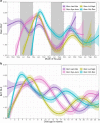Child wasting and concurrent stunting in low- and middle-income countries
- PMID: 37704720
- PMCID: PMC10511327
- DOI: 10.1038/s41586-023-06480-z
Child wasting and concurrent stunting in low- and middle-income countries
Erratum in
-
Author Correction: Child wasting and concurrent stunting in low- and middle-income countries.Nature. 2023 Nov;623(7985):E1. doi: 10.1038/s41586-023-06695-0. Nature. 2023. PMID: 37833391 Free PMC article. No abstract available.
Abstract
Sustainable Development Goal 2.2-to end malnutrition by 2030-includes the elimination of child wasting, defined as a weight-for-length z-score that is more than two standard deviations below the median of the World Health Organization standards for child growth1. Prevailing methods to measure wasting rely on cross-sectional surveys that cannot measure onset, recovery and persistence-key features that inform preventive interventions and estimates of disease burden. Here we analyse 21 longitudinal cohorts and show that wasting is a highly dynamic process of onset and recovery, with incidence peaking between birth and 3 months. Many more children experience an episode of wasting at some point during their first 24 months than prevalent cases at a single point in time suggest. For example, at the age of 24 months, 5.6% of children were wasted, but by the same age (24 months), 29.2% of children had experienced at least one wasting episode and 10.0% had experienced two or more episodes. Children who were wasted before the age of 6 months had a faster recovery and shorter episodes than did children who were wasted at older ages; however, early wasting increased the risk of later growth faltering, including concurrent wasting and stunting (low length-for-age z-score), and thus increased the risk of mortality. In diverse populations with high seasonal rainfall, the population average weight-for-length z-score varied substantially (more than 0.5 z in some cohorts), with the lowest mean z-scores occurring during the rainiest months; this indicates that seasonally targeted interventions could be considered. Our results show the importance of establishing interventions to prevent wasting from birth to the age of 6 months, probably through improved maternal nutrition, to complement current programmes that focus on children aged 6-59 months.
© 2023. The Author(s).
Conflict of interest statement
T.N. is an employee of the Bill & Melinda Gates Foundation. K.H.B. and P.C. are former employees of the Bill & Melinda Gates Foundation. J.C., V.S., R. Hafen and J.H. work as research contractors funded by the Bill & Melinda Gates Foundation.
Figures
















References
-
- Goal 2: End Hunger, Achieve Food Security and Improved Nutrition and Promote Sustainable Agriculture (United Nations, accessed 17 August 2023); https://sustainabledevelopment.un.org/sdg2.
-
- UNICEF, WHO & The World Bank Joint Child Malnutrition Estimates—Levels and Trends (UNICEF & WHO, 2023); https://data.unicef.org/resources/jme-report-2023/.
Publication types
MeSH terms
Grants and funding
LinkOut - more resources
Full Text Sources
Medical

